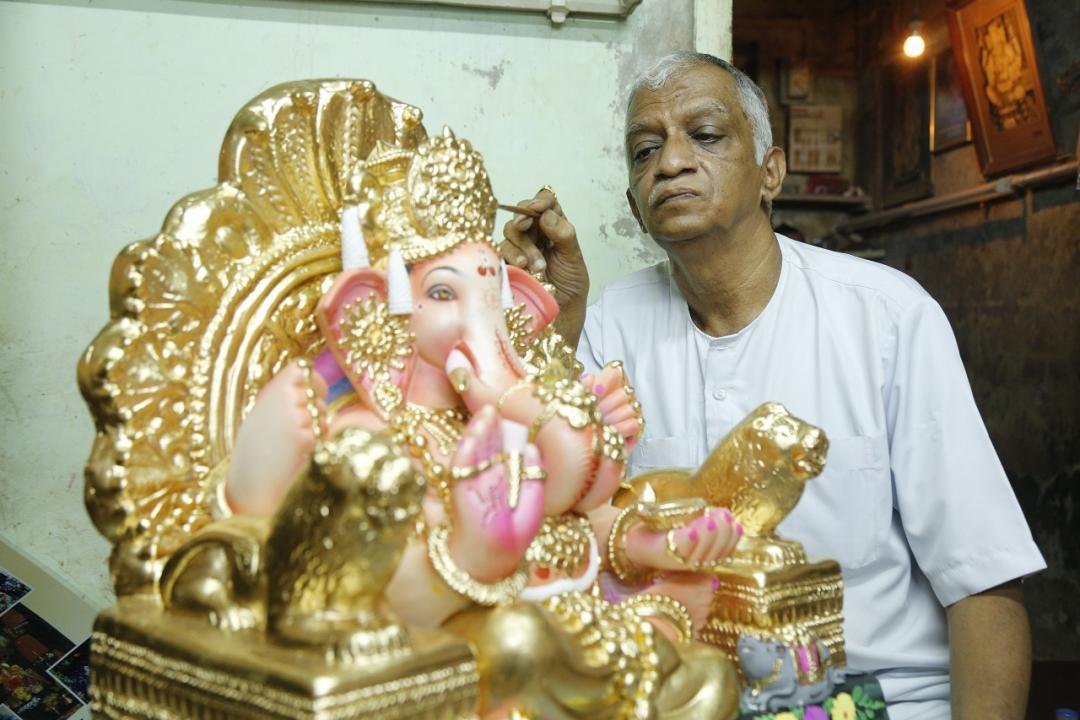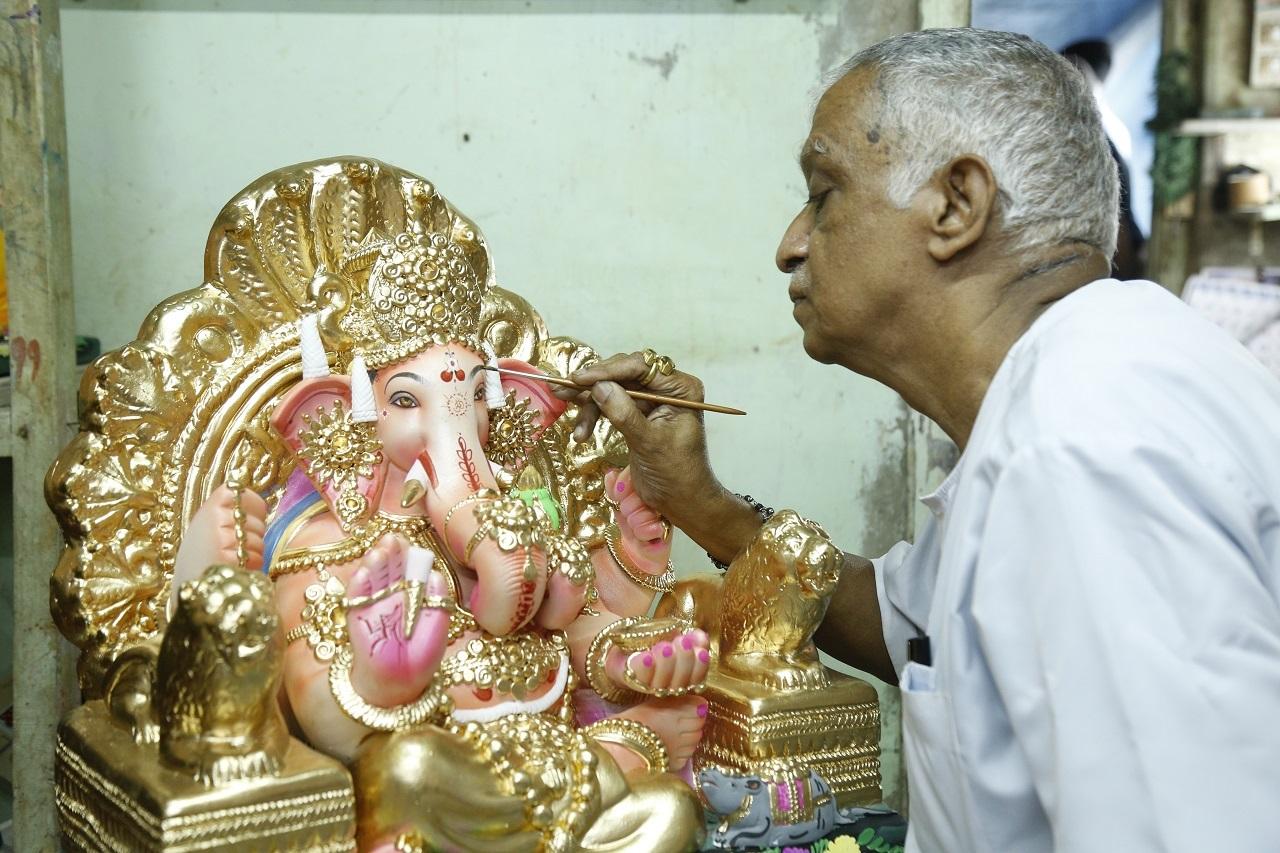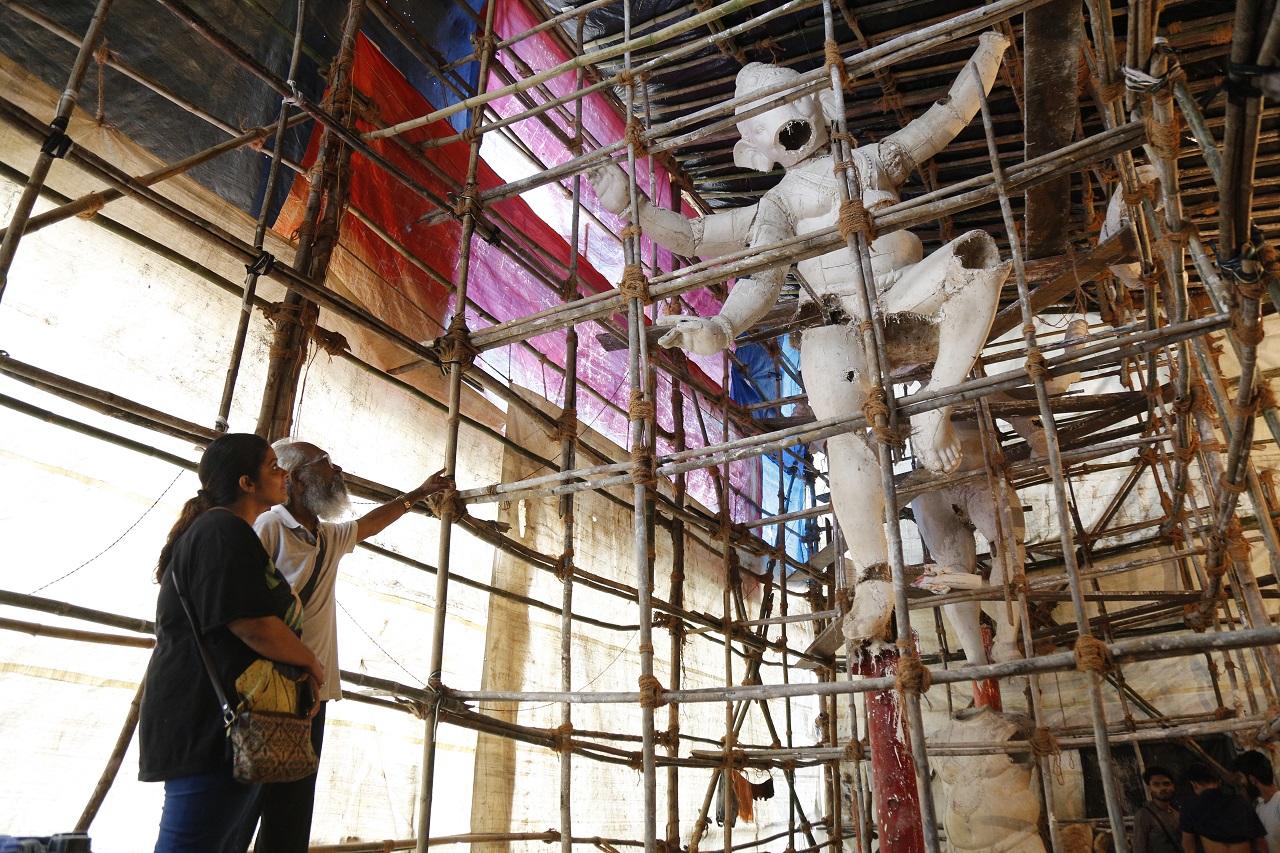Mid-Day speaks to famous murtikars who reveal why young Indians avoid stepping into this field

Pradeep Maduskar at Girgaon workshop. Pic/Manjeet Thakur
Given that Mumbai's biggest festival, Ganesh Chaturthi, is just around the corner, idol makers in the city are losing out on sleep to make the perfect Ganesh idols.
Every year, Ganeshotsav is celebrated with much fanfare across Maharashtra and other states of the country. This year, the festival commences on August 31 and Mumbaikars are into the festive mode to bring bappa home.
Famous Girgaon-based sculptor, Pradeep Maduskar of R.V. Maduskar Arts, recalled how his father started making Ganpati idols in 1939. “My father, Ramkrishna Vishnu Maduskar, started this business in 1939. We used to live in a small house of 10-by-10-foot in Zaobawadi, Girgaon, where he first started with around 25 murtis. After a few years when the business picked up, my father rented a place and turned it into his workshop. From 25, the number went over 200 murtis and that is how the actual business started,” Maduskar shared.

Pradeep Maduskar at Girgaon workshop. Pic/Manjeet Thakur
Speaking about how he got inclined towards being a murtikar (sculptor), Maduskar shared, “I got inspiration from my father. I saw him making murtis when I was a kid. I learnt the art from him. I inherited it from my father. I started making murtis in 1980, the year I received my diploma of sculptors from JJ School of Arts and after I joined the business. Today, we make around 1,500 to 1,600 murtis every year.”
“We make murtis of pure clay (shadu) which is eco-friendly and faces no problem during immersions. This is a major reason why the business saw an uptick,” he added.
Also Read: Ganesh festival: BMC waives off all restrictions on height for private and sarvajanik idols
Explaining the process of how clay murtis are made Maduskar said, “Making murtis is all about skills and how one does it. Our murtis are handmade. But if we are making 10-50 murtis then we make a PoP dye first. It takes around two days to make one murti by hand but with the help of the dye, we can make four murtis a day. However, the dye only helps to give a general form. The sculptor gives it shape and adds aesthetic touches. This way every murtikar should know the artwork. When we remove the murti from the dye the body parts – legs, hands and trunk – are separate. The murtikar should know how to put it together. The jewellery has no dye so the murtikar has to make them by hand. Even when it comes to painting the murti, it is detailed and every murtikar must do it with precision.”
Talking about the challenges that he faced in the business, Maduskar informed, “The main challenge is finding sculptors who know the art of making murtis. We don’t get people easily who are ready to make idols and that is why we do it ourselves. This is pure clay work and art so the younger generation avoids stepping into this field. There are only a few youngsters who have learnt the artwork and come to work with us. Otherwise, it is difficult to find people who are ready to make idols.”
Sharing the financial problems that such murtikars face, Maduskar explained, “This is just a one-day business for which we work 364 days. No one is willing to give us loans. But we managed to get help from our community bank, Sanmitra Sahakari Bank. They have been lending us a helping hand for about 40-50 years.”
The last two years saw muted celebrations owing to restrictions imposed due to the Covid-19. Talking about how it affected the business Maduskar said, “We suffered a lot during the first two years of the pandemic. People were less enthusiastic and there were fewer orders of murtis. The state government had ordered that gharguti (domestic) murtis shouldn’t be more than two feet and visarjan should be done at home or only at civic body-made special ponds, which many people followed. People opted for shadu murtis of one foot so that they can immerse the idols at home. This did severely impact our business."
“Due to the pandemic, small shops which made murtis shut down. Many workers who went to their villages never returned. This is another reason why some murtikars had to shut down their shops. In 2019, we received around 1,400 idol orders. But it dropped in the last two years to 850-900 idols. In 2020, around 600-700 murtis were made and in 2021, we made around 800-900 murtis. This year we have orders of around 1,200 murtis.However, this year there is a little improvement,” Maduskar said.
Also Read: Mumbai: Ayodhya mandir inspires theme for Lalbaugcha Raja
Speaking about how inflation has hit people, Maduskar said, “People are facing financial difficulties due to inflation, one of the reasons why people are thinking twice before spending during festivals. Earlier, people used to celebrate the festival with zest and fervour but now due to the pandemic and price rise that has changed.”
Mid-Day visited Vijay Khatu Arts, which introduced 25-30 ft tall Ganesh murtis in Mumbai.
Reshma Khatu, daughter of the famous murtikar Vijay Khatu, recalled how the studio started. “My grandfather, Ramkrishna Vishwasnath Khatu, started it in 1947. After that, my dad and my two uncles took it forward. Now I am the third generation who is looking after the business. Our brand has completed 75 years this year,” she said.

Reshma Khatu at workshop in Byculla. Pic/Manjeet Thakur
Khatu said, “In 2017, after my father passed away, a lot of work was pending. I did not know the field. But my dad was well-known in this field and had created his own brand, which is why I wanted to continue his legacy.”
Explaining how her studio makes murtis of 20-26 feet, Khatu said, “It's like engineering work. First, the structure and welding work of iron rods is done to make the base. Then body parts are made from cast and they are cut according to shape, size, design, and pose. Then we put them together and finish the murtis and then paint them at last.”
This year Khatu did not rent the sprawling Central Railway Workshop ground in Parel like she usually does. The 2022 orders are being completed at a smaller venue in Bakri Adda near Byculla.
“In 2019, there was no such thing as permissions. But since the outbreak of Covid-19, there are many rules and regulations that need to be followed. Though this year there are no regulations, we took permission for everything,” Khatu explained.
Speaking about how Covid-19 impacted the business, Khatu said, “Due to the pandemic, the sculptors went to different industries and now after two years we are finding it difficult to find new workers who can make big murtis.”
Khatu also said that from this year onwards she will keep a bare minimum scale of operations. “Earlier, we had fixed orders of about 100-150 murtis. But, from this year I have decided that in the future too, I will keep a bare minimum scale of operations. We will only make signature faces like Chintamani or Chandanwadi and the quantity will be 10-15. And we only accept orders of signature faces and orders of old mandals,” she signed off.
 Subscribe today by clicking the link and stay updated with the latest news!" Click here!
Subscribe today by clicking the link and stay updated with the latest news!" Click here!










